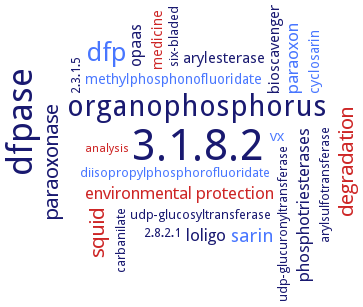3.1.8.2: diisopropyl-fluorophosphatase
This is an abbreviated version!
For detailed information about diisopropyl-fluorophosphatase, go to the full flat file.

Word Map on EC 3.1.8.2 
-
3.1.8.2
-
dfpase
-
organophosphorus
-
dfp
-
degradation
-
squid
-
paraoxonase
-
sarin
-
phosphotriesterases
-
paraoxon
-
environmental protection
-
loligo
-
opaas
-
arylesterase
-
bioscavenger
-
vx
-
methylphosphonofluoridate
-
medicine
-
cyclosarin
-
six-bladed
-
carbanilate
-
udp-glucosyltransferase
-
diisopropylphosphorofluoridate
-
2.8.2.1
-
arylsulfotransferase
-
udp-glucuronyltransferase
-
2.3.1.5
-
analysis
- 3.1.8.2
- dfpase
-
organophosphorus
- dfp
- degradation
- squid
- paraoxonase
- sarin
- phosphotriesterases
- paraoxon
- environmental protection
-
loligo
-
opaas
- arylesterase
-
bioscavenger
- vx
- methylphosphonofluoridate
- medicine
- cyclosarin
-
six-bladed
-
carbanilate
- udp-glucosyltransferase
- diisopropylphosphorofluoridate
-
2.8.2.1
- arylsulfotransferase
-
udp-glucuronyltransferase
-
2.3.1.5
- analysis
Reaction
Synonyms
DFPase, di-isopropylphosphorofluoridate fluorohydrolase, dialkylfluorophosphatase, diisopropyl fluorophosphatase, diisopropyl phosphorofluoridate hydrolase, diisopropylfluorophosphatase, diisopropylfluorophosphonate dehalogenase, diisopropylphosphofluoridase, EC 3.8.2.1, h-PON1, isopropylphosphorofluoridase, More, OP-hydrolyzing enzyme, OPA anhydrase, OPA anhydrolase, OPAA, OPAA-2, opd, OPH, organophosphate acid anhydrase, organophosphate anhydrolase/prolidase, organophosphorus acid anhydrolase, organophosphorus hydrolase, organophosphorus-hydrolyzing enzyme, paraoxonase 1, phosphotriesterase, PON1, PTES5, RC, regucalcin, senescence marker protein-30, SMP30, somanase, tabunase


 results (
results ( results (
results ( top
top






